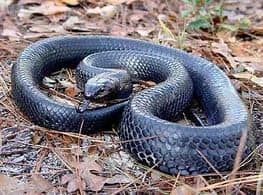Eastern Indigo SnakeDrymarchon couperi |

Custom Search
|
Nowadays the eastern indigo snake has been extirpated from Mississippi and Alabama, and is found only in peninsular Florida and southeast Georgia, persists in the Florida panhandle, but in much lower numbers than in the past.
These snakes are active strictly by day, in the summer they stay preferably near wetland edges, moving long distances to drier habitats into their winter dens in sandhill habitats. They are known for their use of gopher tortoise burrows either for nesting and refuge from intense heat during the hot summer months or as a winter den. They inhabit a variety of ecosystems including dry glades, xeric sand ridges, stream bottoms, flatwoods, hammocks, cane fields, riparian thickets, and higher ground with drained sandy soils. Eastern indigo snakes are large smooth-scaled and shiny bluish-black colored snakes, including their belly. They are the longest non-venomous snake native to the United States, ranging in size from 60 to 84 inches (152-213 cm), with the maximum recorded specimen measuring 9.2 ft (2.8 m), closely followed by the black rat snake(Pantherophis obsoletus). Large specimens over 8.5 ft (2.6 m), can weigh up to 11 lb (5 kg) but even though indigo snakes are large some extremely large specimens of the co-occurring and highly venomous eastern diamondback rattlesnakes (Crotalus adamanteus) can outweigh them. When cornered or threatened the eastern indigo snake flattens its head, hiss and vibrates the tail, producing a rattling sound trying to mimic venomous rattlesnakes. But even so, these snakes rarely bite.

The eastern indigo snake is sexually dimorphic, but in this case, males grow larger than females with average sizes of 5 ft for males and 4.5 ft for adult females.
The sides of the head, throat, and chin are usually reddish or orange-brown in color, and while juveniles are very similar to adults their heads are much redder. The species generic name, Drymarchon is composed of the Greek words "drymos", meaning "forest", and archon meaning "lord" and translates to “lord of the forest”. The species-specific name derives from the Latinization of the American planter James Hamilton Couper (1794-1866) surname. The eastern indigo has several other common names including the most usual blue indigo snake but also blue gopher snake, black snake, blue bull snake or simply indigo snake. Species / Taxonomy The species was first described by John Edwards Holbrook in 1842 and until the early 90's, the eastern indigo snake was considered monotypic with 12 recognized subspecies. Diet / Feeding The eastern indigo snake like all snakes is carnivorous and will kill and eat any other small animal it can overpower, consuming it head-first. They feed mainly on turtles, small tortoises, small mammals, toads, frogs, birds and eggs, lizards and other snakes including other venomous snakes. Sometimes when feeding they are bitten by venomous snakes, like the eastern diamondback rattlesnake, but they are mostly immune to rattlesnake venom. These aren't your typical constrictor snakes, they overpower their prey using their muscular jaws, and are known to kill prey by violently beating it against the ground or nearby objects. Younger snakes have a very similar diet to that of the adult specimens, they simply feed on smaller prey. Reproduction The eastern indigo snake breeding season occurs from October to February, in the peak of winter but they remain active at temperatures 50 to 60 F, too cool for other snakes. The eastern indigo is an oviparous snake, meaning its females lays eggs. The eastern indigo females will then lay a single clutch of 4 to 12 eggs, usually during the months of May or June. Although there's a little information about nest sites, gopher tortoise burrows are probably a favored nesting location. The hatchlings are large and measure about 16 in. (40 cm) and weigh about 1.5 oz. (40 g). Conservation / Threats The eastern indigo snake is listed as "Least Concern" species by the IUCN, because of their fairly large range and presumed large population size. The main threat to the eastern indigo snake is habitat loss, fragmentation, and alteration, but their population numbers are also affected by wanton killings, highway fatalities and overcollection for the pet trade. The practice of gassing gopher tortoise burrows to drive out venomous rattlesnakes, most of the times killed or harmed not only gopher tortoises but other animals occupying it, including eastern indigo snakes. They are listed as a federally threatened species in Florida and Georgia and considered possibly extirpated within Alabama by the Alabama Department of Conservation and Natural Resources. Due to their docile nature and stunning appearance, people seek them as pets, although the species protected status means that owning one may require a permit depending on location.
|
Did You Know?
Because of the "Mojave toxin" the Mojave rattlesnake venom is regarded as the most toxic of any rattlesnake. Scientific classification |
© 2014 Snake Facts About Us | Privacy Policy | Contact




